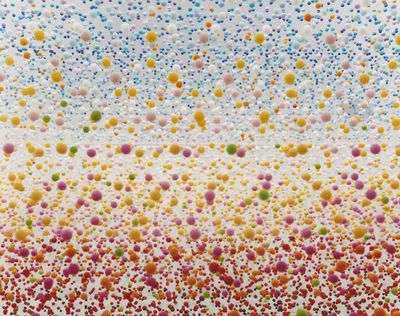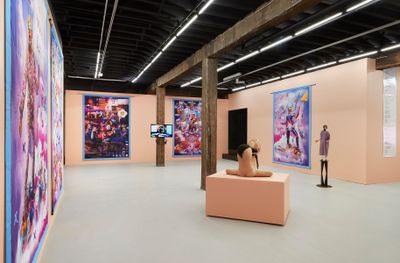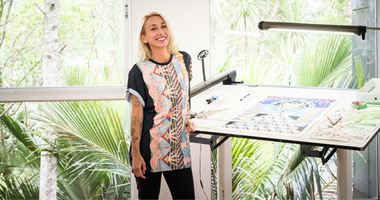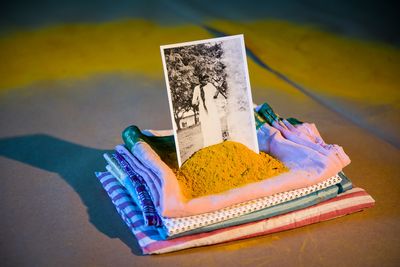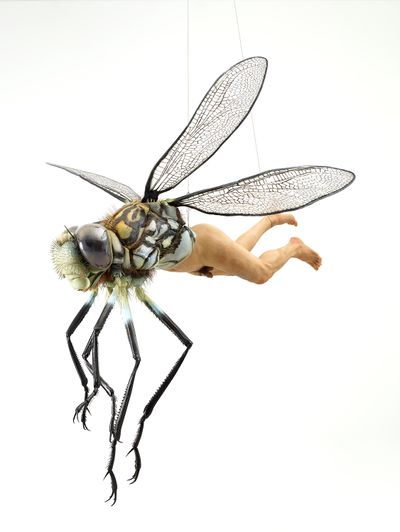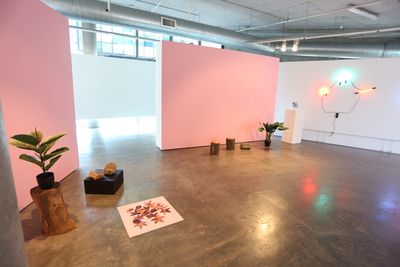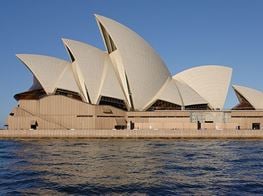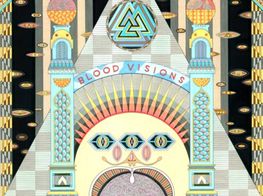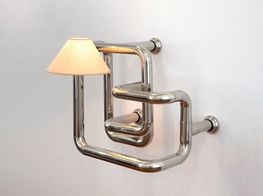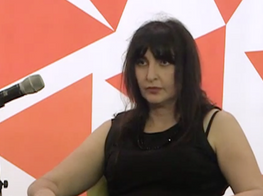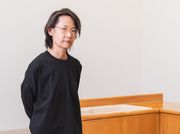Sydney Exhibitions to See: 2018 Lowdown

Honey Long & Prue Stent, Neptune's Necklace (2018). Archival pigment print. 106 x 159 cm. Courtesy © the artists and ARC ONE Gallery.
Sydney Contemporary returns to Carriageworks for its fourth edition between 13 and 16 September 2018 with 87 local and international galleries and a full programme of performances, talks, large-scale curated installations and tours. Beyond the fair, Sydney is abundant with standout shows that challenge perceptions around identity, the body, and technology through contemporary art. These ambitious presentations engage national and international artists with a diversity of inter-generational practices and material forms.
Spacemakers and roomshakers
Art Gallery of New South Wales, Art Gallery Rd
14 July–21 October 2018
This showstopper of an exhibition brings out some of the most spectacular large-scale works of the Art Gallery of New South Wales' collection. Curated by Justin Paton, Spacemakers and roomshakers brings together established, mid-career, and emerging artists who approach space in radically different ways. Employing different approaches to form, light, sound, and materiality, artworks are spread out over the contemporary galleries, with ample breathing space given to each presentation. Nike Savvas's room installation Atomic: full of love, full of wonder (2005) is comprised of thousands of colourful, gently oscillating, suspended balls; while Ernesto Neto's Just like drops in time, nothing (2002) suspends stretched polymer fabric filled with spices.
The contemporary artworks included in this show occupy the grandeur of the Art Gallery of New South Wales in a manner that feels thoughtful andsensitive. Take, for example, In transit (double-function form) (2018), but Korea-born, New Zealand-based artist Yona Lee. This ambitious project is made entirely from steel that lines the edges and joints of the gallery's architecture to mimic utilitarian railings and barriers, while providing space for visitors to rest and socialise.
THE PUBLIC BODY .03
Artspace Sydney, The Gunnery, 43–51 Cowper Wharf Roadway, Woolloomooloo
30 August–28 October 2018
THE PUBLIC BODY .03 is the final in a series of three exhibitions exploring the body in contemporary art, with the first show exploring the explicit state of nakedness, and the second exploring feminist, queer and anti-racist subjectivities. For this iteration, 20 national and international artists situate the body as a network detached from its physical form. Themes of hybridity and the uncanny speak to the complexities and anxieties brought about by contemporary modes of living, including the internet as a tool that shapes self-hood and relationships. The walls and plinths of the show are painted an almost fleshy 'millennial' pink, which saturates and transforms the architecture of the gallery into a bodily extension.
Jess Johnson's wallpaper (Webwurld, 2017) and Patricia Piccinini's phallic bat-like sculptures (The Grotto, 2018) greet you as you enter the show, but as a whole it consists largely of video works by artists such as Cécile B. Evans, Jacolby Satterwhite, Korakrit Arunanondchai and Kate Cooper. Jon Rafman's Dream Journal (2016–2017) produces a Joycean narrative that goes deep into the dark recesses of the unconscious to explore the disturbing effects of information overload on the subconscious.
Make sure to come back for performances by Archie Barry, Wednesday 26 September, 7pm and Angela Goh, Saturday 27 October, 2pm. Artspace is also teaming up with Sydney Contemporary for the Artist Party on Saturday 15 September, 6pm with a performance by Sydney-based artist Tina Havelock Stevens.
Temporary Certainty
4A Centre for Contemporary Asian Art, 181–187 Hay St, Haymarket
31 August–14 October 2018
Temporary Certainty is a poignant exploration of activism and humanity in tumultuous times. The exhibition presents new works by Kurdish artist Rushdi Anwar and Australian artist Alana Hunt, as well as a new body of work by Bangladeshi documentary photographer Sarker Protick. Works are concerned with contemporary shifts across greater Asia, and redefining notions of identity, displacement, nationalism, and sovereignty.
Rushdi Anwar's practice draws on the artist's relationship with the Kurdish diaspora, which he is a part of. Facing Living: The Past in the Present (2015) is a series of photographs depicting someone tearing an official portrait of former Iraqi dictator Saddam Hussein and piecing it back together with black tape, eventually concealing the entire image. Dealing with issues of censorship, erasure, and the trauma of memory, the cycle of tearing and mending in the film becomes a reminder of the hypocrisy by those in power to repeat the wrongs of their predecessors and the refusal to learn from past mistakes. Alana Hunt takes a very different approach by exploring notions of environmental and economic displacement in rural Kununurra, a small town in Western Australia, highlighting how colonisation continues to eradicate areas of significance for Indigenous communities (Faith in a pile of stones, 2018).
As a whole, this exhibition honours the power of images and the critical role of artists in encouraging change. Bangladesh is in a heightened political state, with the influx of Rohingya refugees into camps along its border, and recent protests that led to the arrest of Al Jazeera reporter Shahidul Alam. Sarker Protick's photographs and videos trace the architectural landscape of East Bengal, exploring the decaying buildings that exist along the feudal lands that were abandoned during the 1971 Liberation War.
We are all connected to Campbelltown (one way or another)
Campbelltown Arts Centre, 1 Art Gallery Rd, Campbelltown
11 August–14 October 2018
The title of this exhibition is, in itself, an invitation to think laterally about one's relationship to a place, a community, and the art world more broadly. Part of Campbelltown Arts Centre's 30-year anniversary, We are all connected to Campbelltown (one way or another) brings together 13 artists and artist collectives to speak about the history of Campbelltown, a suburb of Greater Western Sydney.
This inter-generational presentation is a result of the Centre's four past and present directors each selecting one significant artist who they believe had the greatest impact on the gallery and community during their tenure. A highlight is Heath Franco's new site-specific work, YOUR DIRECTOR (2018), which presents a 1:1 scale replica of current Director Michael Dagostino's office overlayed with video elements that depict camouflaged life forms imagined to exist in the office environment. Bringing the back of house production into the gallery space shifts the power dynamic, opening the office into the public realm.
As a celebration of an arts centre that has carved its own voice in Western Sydney, We are all connected to Campbelltown (one way or another) speaks to the legacies of artists that can and do inform the practices of younger generations, while foregrounding the role of artists as agents who shape cultures, communities, and public debates.
Between Suns
Cement Fondu, 36 Gosbell St, Paddington
21 July–16 September 2018
At a time when refugee and immigration stories are often told second-hand, notably by the media and politicians, it is refreshing to find an exhibition that gives a platform to artists who have direct migrant experiences. Underscored by themes of anxiety, Between Suns negotiates the complexity and human impact of lives that are in transition.
Shivanjani Lal's installation on the mezzanine level, Khet (2018), is a moving and deeply personal work that explores the artist's personal ancestry through three nonlinear narratives: the indentured labour community of Fiji; the role of the landscape in providing sites for healing; and her personal grief over the loss of her paternal grandmother. The floor of the space is covered in brown paper and in the centre of the room is a small shrine that includes an aromatic circle of turmeric with a photograph of her grandmother at its centre. Overlooking this shrine at the end of the room is the video projection 12 Gestures for the People I love (2018), which documents the artist offering a traditional gesture of Pranama 'respectful salutation or bowing' to her ancestral mother country of India—the khet, or landscape, from which she is now displaced. Downstairs is Khaled Sabsabi's installation Ali or 3li (2005). Consisting of two screens on two facing walls, the work shows sunrises facing East to West, a literal response to the exhibition title and a reminder that we all exist under this one sun no matter where we come from.
The works in this exhibition present raw, sometimes hopeful, and often challenging insights into the continuing psychological impacts of living life in a state of detention. In the Project Space are drawings and paintings created by participants of the Refugee Art Project, a community organisation that has facilitated art workshops since 2011, starting at the Villawood Immigration Detention Centre.
Supernatural
White Rabbit Gallery, 30 Balfour St, Chippendale
7 September 2018–3 February 2019
Supernatural explores the ancient and modern worlds to reimagine contemporary China through real and imagined 21st-century landscapes. Curator David Williams explains that in ancient China, people believed that mountains and caves were the dwellings of immortals, and that supernatural beings inhabited the landscape. Today, the landscape is littered with mega-cities and impenetrable fog. The landscape here is often disconcerting—what is familiar is also strange, and a sense of foreboding and eeriness looms. Zhou Xiaohu's Garden of Earthly Delights (2016) sees the artist transform Hieronymus Bosch's eponymous painting into a surreal film of human and animal hybrids acting out, while Emily Shih-Chi Yang's The Blessed Mountains (2012) merges the techniques of traditional Chinese calligraphy with American abstraction.
From traditional landscape painting to peculiar contemporary figures, this exhibition turns the natural on its head to question our relationships to superstition and the unexplained. Over the three levels of exhibition space, works play with scale and detail to offer surprising and nuanced reflections. Yan Wei Lin's Oceans of Cloth Wheels and Floating Islands (2013–2016) consists of thousands of indigo-dyed cloth discs hanging from the ceiling that tilt and turn like an undulating ocean as you move around them. Li Shan's series 'Deviation' (2017) comprises ten human-sized sculptures of human/dragonfly hybrids that looks like they've escaped a mad scientist's lab.
Human Jerky: meatbags through the eyes of technology
Emotions invented by the Internet
Verge Gallery, Jane Foss Russell Plaza, City Rd
16 August–22 September 2018
Human Jerky: meatbags through the eyes of technology and Emotions invented by the Internet are two exhibitions that appear lighthearted, yet reveal the sinister technologies infecting our everyday lives today. Both shows look at technology and the internet from the inside out—dissecting, analysing, and reimagining these contemporary tools to question their impact on emotions, relationships, and subjectivities.
Human Jerky is concerned with modern robotics as fundamentally carnal as they manage the tasks of human needs and desires. Tully Arnot's work Lonely Sculpture (2014) embodies this theme as a single silicone finger attached to a robotic motor that endlessly swipes right on every Tinder profile it comes across, blurring a human act—and desire for connection—with the isolation of digital technologies. Louise Zhang's series of monstrous masses ooze pustules of pastel and glitter that explode into abstract matter layered on top of one another.
Emotions invented by the Internet explores emotional states that are induced by connecting to someone—or something—online. Through analogue and digital design, emerging artists Jessica Herrington and Anna Madeleine have developed augmented and virtual reality to create moments of meditation within the hardware of the gallery space and the software of the digital realm.
OCEANS FROM HERE
Australian Centre for Photography, 72 Oxford St, Darlinghurst
7 September–20 October 2018
This exhibition is the second in a two-part series exploring the aesthetics of water through photography, and features seven artists, including Grant Stevens and Kai Wasikowski, who both use travel and photography to capture moments in nature. Where Wasikowski's work is occupied by the ideological aestheticisation of nature by confounding our understanding of it as a perceptual experience, Stevens is interested in the possibilities of contemplation and self-reflection in the age of social media and information overload. Taking 'Instagram perfect' photographs of waterfalls, Stevens attempts to portray an idealised nature that stands in for romanticism and fantasy.
As a whole, OCEANS FROM HERE is a concise and refined exhibition that uses a single theme to expand on our connection to water through aesthetic introspection. The show takes into account the fact that water is one ofnature's most universally vital elements, but it is also a paradox. We are made of water and need it to exist—yet it is also a threatening force that can destroy nations and end lives.
This idea of water as a separator and connector is explored in the work of Honey Long and Prue Stent, who produce large-scale surreal photographs of performing female bodies in the landscape, exposing their forms to the elements, and submerging bodies into pools of water. Both alluring and unsettling, their images play with a potent connection to the land. As a descendant of the Worimi nation, Dean Cross draws on his ancestry to interrogate sociopolitical and cultural norms. In this show, we see documentation of the artist covering his own body in ochre, a colour sourced from the earth as a symbolic return to country. —[O]

